Battle of Saipan
All around us was the chaotic debris of bitter combat. Jap and marine bodies lying in mangled and grotesque positions; blasted and burnt-out pillboxes; the burning wrecks of LVTs that had been knocked out by Jap high velocity fire; the acrid smell of high explosives; the shattered trees; and the churned-up sand littered with discarded equipment.
-First Lieutenant John C. Chapinin, Third Battalion, 24th Marines.
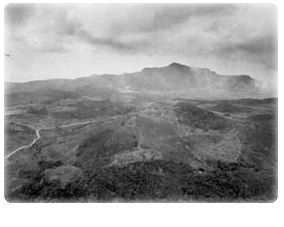
During February and March, 1944, at the Washington Planning Conference, the planners of the Pacific Campaign of
World War II decided that the primary objective for the near future was to establish a base in the region of Luzon, Formosa, and the Chinese Coast. That objective quickly established the island of Saipan (northern isle of the Marianas) as the next prime candidate.
The planners believed that from that base, vital lines of communications from Japan to the Netherlands Indies could be severed. They also believed that bases in the area could be used by B-29 long-range bombers to attack the Japanese home islands. The planners further believed that if an invasion of Japan were to occur, those bases could be used as staging areas for the vast numbers of soldiers that would be required.
The operational plan for Saipan, code-named Forager, called for an assault on the island's west side, with the Second Marine Division on the left and the Fourth Marine Division on the right. The
U.S. Army's 27th Infantry Division waited in reserve, ready to be fed into the battle if needed.
The invasion of Saipan was a vital strategic step for the United States forces to defeat the Emperor, and the Japanese knew it. They were dug in and waiting for the Americans to proceed to the beaches before "releasing hell" on them.
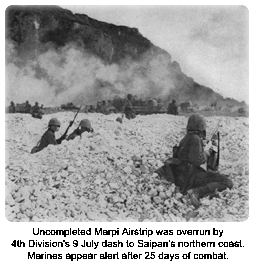 Pre-invasion
Pre-invasion
On June 11th, 1944, Task Force 58 launched 225 planes to the Southern Marianas. The objective of the mission was to take out both Japanese aircraft and air facilities. The strike destroyed between 150 and 215 planes. Over the next three days, the navy flew strikes against Saipan with the further objective of destroying coastal defensive sites and burning the cane fields south of Mutcho Point, to facilitate an amphibious landing. During those three days, another 50 planes were destroyed and 68 damaged.
Although the strikes destroyed Japanese aircraft, the amount of damage inflicted on the airfields and gun positions was limited. The dirt airstrips could be quickly repaired and only a direct hit would damage the gun emplacements. Due to the actions of the air strikes from June 11th to the 15th, however, remaining Japanese aircraft created no more than a slight nuisance against the landing force during the entire Marianas Campaign.
The most critical phase of the Battle for Saipan was the fight for the beaches. To succeed, the
marines had to establish a beachhead onto which sufficient troops, heavy equipment, and supplies could be brought ashore. On the first day, the marines gained tenuous control of the beaches, but they were not secure, since artillery and heavy weapons fire still rained on men and equipment. Six more days would be required to secure the beaches.
D-Day on Saipan
On June 15th, 1944,
U.S. Marines once again would show the world why they were referred to as "devil dogs" by the Germans half a world away. With plenty of grit and determination, marine divisions would relentlessly cross the beaches of Saipan.
At first light, the Navy fire support ships of Task Force 58, lying off Saipan Island, increased their previous days' preparatory firing involving all calibers of weapons. At 5:42 a.m., Vice Admiral Richmond Kelly Turner ordered, "Land the landing force."
Around 7 a.m., tank LSTs (landing ships) moved to within approximately 1,250 yards behind the line of departure. Marines in the LSTs began to progress from them into LVTs (tracked landing vehicles). Control vessels containing navy and marine personnel with their radio gear took their positions, displaying flags indicating which beach approaches they controlled.
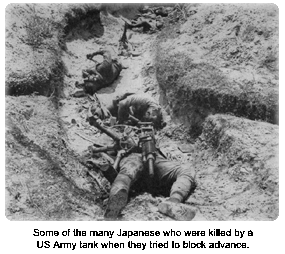
Around 8 a.m., amphibious tanks and tractors began their movement toward the beaches. Seventy-two planes bombarded the beaches as the first waves of the amphibious landing force were approximately 800 yards from the beach. Cover aircraft then shifted their attack inland when the tanks and tractors were within 100 yards of the beach. The main attack of the marine divisions was centered near the southwestern Saipan beach village of Chalan Kanoa.
The landing area was well registered for artillery and the Japanese had 16 105mm, 30 75mm, and eight 150mm guns on the high ground overlooking the beaches and were extremely accurate due to the precise sighting in of the guns and the use of bamboo sticks to help in adjusting fire.
As the U.S. soldiers stormed the beaches of Saipan, it soon became clear that it wasn't going to be an easy task. Two thousand marines became casualties, but 20,000 were ashore by nightfall.
Japanese counterattack
At 8 p.m., a large force of Japanese infantry, supported by tanks, counterattacked the left flank of the Sixth Marines, Second Marine Division. Fortunately, naval "star shells" lit up the sky enough for the defending marines to see the outlines of Japanese soldiers as they lurked in the night. The marines' machine guns and heavy rifle fire, along with the assistance of a battalion of 75mm howitzers, stalled the Japanese counterattack.
At 3 a.m. and just before daylight, tanks and infantry attacked the defending marines again. Those last attempts were not strong enough to overwhelm the rugged Second Marine Division.
On the evening of the 16th, the 27th Infantry Division landed on Saipan. Their objective was to capture Aslito airfield and to isolate the Japanese in the island's southeast corner.
Meanwhile, the Second and Fourth Marine divisions continued their push past the beaches. By the fourth day the Japanese had given up trying to defend the beaches and had moved inland to set up defenses in the hilly and mountainous terrain.
Mount Tapotchau
Saipan represented a new prickly problem for an American assault. Instead of a small, flat coral islet in an atoll, it was a large island target of some 72 square miles, with terrain varying from flat cane fields to swamps, to breakneck cliffs, to the 1,554-foot-high Mount Tapotchau.
On June 21st, the 27th Infantry Division moved in between the Second and Fourth Marine divisions to conduct a three-division attack on Mount Tapotchau. The 27th Infantry began a grueling fight up the mountain, while the Second Marines continued to move northeast, and the Fourth Marines attacked eastward on the relatively flat, but heavily defended Kagman Peninsula.
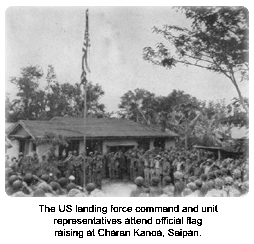
After two days of fighting, the division's attack against the main Japanese defensive force ground down to a stalemate. The Second Marines were on the outskirts of the coastal village of Garapan, and near the summit of Mount Tapotchau. The 27th Infantry had made minimal progress, and the Fourth Marines had overrun the majority of the peninsula and were nearing the island's eastern side. However, the main Japanese defense on Mount Tapotchau remained intact.
During those two days of fighting in caves, ravines, and gullies, the Second Marines lost 333 men, the 27th Infantry lost 277 men, and the Fourth Marines lost 812 men. American artillery and tanks were generally useless in a jungle environment filled with broken terrain. The fighting was mainly man-to-man with mortars and machine guns providing the heavy firepower. Close air support was nearly non-existent due to the demands of the Battle of the Philippine Sea.
On July 5, the 27th Infantry and the Fourth Marines finally captured Mount Tapotchau and pushed northward up the narrowing island. Due to the narrowing of the front, the Second Marine Division was pulled into reserve.
Banzai rush
On July 7, the battle to secure the Japanese-occupied island of Saipan crested in one of the largest
banzai charges of the Pacific War. That charge — which lasted more than 15 hours — brought the total combined Japanese and American casualties for the bloody campaign to more than 30,000.
"Suddenly there is what sounded like a thousand people screaming all at once, as a hoard of 'mad men' broke out of the darkness before us. Screams of 'Banzai' fill the air, Japanese officers leading the 'devils from hell,' their swords drawn and swishing in circles over their heads. Jap soldiers were following their leaders, firing their weapons at us and screaming 'Banzai' as they charged toward us.
Our weapons opened up, our mortars and machine guns fired continually. No longer did they fire in bursts of three or five. Belt after belt of ammunition went through that gun, the gunner swinging the barrel left and right. Even though Jap bodies built up in front of us, they still charged us, running over their comrades' fallen bodies. The mortar tubes became so hot from the rapid fire, as did the machine gun barrels, that they could no longer be used."
- First Lieutenant John C. Chapin
July 8th quickly became the beginning of the end. The Japanese had spent the last of their unit manpower in the banzai charge; now it was time for the final American "mop-up." LVTs rescued men of the 105th Infantry who had waded out from the shore to the reef to escape the Japanese. Holland Smith then moved most of the 27th Infantry into reserve, and put the Second Marines back on the line of attack, with the 105th Infantry attached. Together with the Fourth Marines, they swept north toward the end of the island.
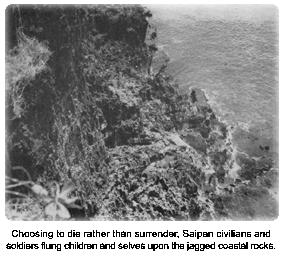
By the time the Americans reached the northern end of Saipan on July 9, thousands of the island's men, women, and children were at the top of the cliffs overlooking the shark-infested waters. And because of pre-invasion propaganda that had been distributed by the Japanese to citizens of the island, many natives were horrified of being tortured and maimed if captured by the Americans.
Despite loud speaker efforts of Americans attempting to persuade the enemy away from the cliffs, reason would not come to be. Hundreds of natives and soldiers jumped from the cliffs of northern Saipan (some were thrown by Japanese soldiers), while others committed suicide by holding onto grenades in caves. All but 1,000 of the Japanese military soldiers were dead, along with 22,000 civilians.
End of a dynasty
After the fall of Saipan, Premier Hideko Tojo declared that Japan had come face to face with a national crisis, a crisis that was unprecedented in its history. The following month, Tojo and his entire war cabinet resigned. That liquidation resignation was a major turning point in the war, because until then the military had essentially been in charge of the government.
 During February and March, 1944, at the Washington Planning Conference, the planners of the Pacific Campaign of World War II decided that the primary objective for the near future was to establish a base in the region of Luzon, Formosa, and the Chinese Coast. That objective quickly established the island of Saipan (northern isle of the Marianas) as the next prime candidate.
The planners believed that from that base, vital lines of communications from Japan to the Netherlands Indies could be severed. They also believed that bases in the area could be used by B-29 long-range bombers to attack the Japanese home islands. The planners further believed that if an invasion of Japan were to occur, those bases could be used as staging areas for the vast numbers of soldiers that would be required.
The operational plan for Saipan, code-named Forager, called for an assault on the island's west side, with the Second Marine Division on the left and the Fourth Marine Division on the right. The U.S. Army's 27th Infantry Division waited in reserve, ready to be fed into the battle if needed.
The invasion of Saipan was a vital strategic step for the United States forces to defeat the Emperor, and the Japanese knew it. They were dug in and waiting for the Americans to proceed to the beaches before "releasing hell" on them.
During February and March, 1944, at the Washington Planning Conference, the planners of the Pacific Campaign of World War II decided that the primary objective for the near future was to establish a base in the region of Luzon, Formosa, and the Chinese Coast. That objective quickly established the island of Saipan (northern isle of the Marianas) as the next prime candidate.
The planners believed that from that base, vital lines of communications from Japan to the Netherlands Indies could be severed. They also believed that bases in the area could be used by B-29 long-range bombers to attack the Japanese home islands. The planners further believed that if an invasion of Japan were to occur, those bases could be used as staging areas for the vast numbers of soldiers that would be required.
The operational plan for Saipan, code-named Forager, called for an assault on the island's west side, with the Second Marine Division on the left and the Fourth Marine Division on the right. The U.S. Army's 27th Infantry Division waited in reserve, ready to be fed into the battle if needed.
The invasion of Saipan was a vital strategic step for the United States forces to defeat the Emperor, and the Japanese knew it. They were dug in and waiting for the Americans to proceed to the beaches before "releasing hell" on them.
 Pre-invasion
On June 11th, 1944, Task Force 58 launched 225 planes to the Southern Marianas. The objective of the mission was to take out both Japanese aircraft and air facilities. The strike destroyed between 150 and 215 planes. Over the next three days, the navy flew strikes against Saipan with the further objective of destroying coastal defensive sites and burning the cane fields south of Mutcho Point, to facilitate an amphibious landing. During those three days, another 50 planes were destroyed and 68 damaged.
Although the strikes destroyed Japanese aircraft, the amount of damage inflicted on the airfields and gun positions was limited. The dirt airstrips could be quickly repaired and only a direct hit would damage the gun emplacements. Due to the actions of the air strikes from June 11th to the 15th, however, remaining Japanese aircraft created no more than a slight nuisance against the landing force during the entire Marianas Campaign.
The most critical phase of the Battle for Saipan was the fight for the beaches. To succeed, the marines had to establish a beachhead onto which sufficient troops, heavy equipment, and supplies could be brought ashore. On the first day, the marines gained tenuous control of the beaches, but they were not secure, since artillery and heavy weapons fire still rained on men and equipment. Six more days would be required to secure the beaches.
D-Day on Saipan
On June 15th, 1944, U.S. Marines once again would show the world why they were referred to as "devil dogs" by the Germans half a world away. With plenty of grit and determination, marine divisions would relentlessly cross the beaches of Saipan.
At first light, the Navy fire support ships of Task Force 58, lying off Saipan Island, increased their previous days' preparatory firing involving all calibers of weapons. At 5:42 a.m., Vice Admiral Richmond Kelly Turner ordered, "Land the landing force."
Around 7 a.m., tank LSTs (landing ships) moved to within approximately 1,250 yards behind the line of departure. Marines in the LSTs began to progress from them into LVTs (tracked landing vehicles). Control vessels containing navy and marine personnel with their radio gear took their positions, displaying flags indicating which beach approaches they controlled.
Pre-invasion
On June 11th, 1944, Task Force 58 launched 225 planes to the Southern Marianas. The objective of the mission was to take out both Japanese aircraft and air facilities. The strike destroyed between 150 and 215 planes. Over the next three days, the navy flew strikes against Saipan with the further objective of destroying coastal defensive sites and burning the cane fields south of Mutcho Point, to facilitate an amphibious landing. During those three days, another 50 planes were destroyed and 68 damaged.
Although the strikes destroyed Japanese aircraft, the amount of damage inflicted on the airfields and gun positions was limited. The dirt airstrips could be quickly repaired and only a direct hit would damage the gun emplacements. Due to the actions of the air strikes from June 11th to the 15th, however, remaining Japanese aircraft created no more than a slight nuisance against the landing force during the entire Marianas Campaign.
The most critical phase of the Battle for Saipan was the fight for the beaches. To succeed, the marines had to establish a beachhead onto which sufficient troops, heavy equipment, and supplies could be brought ashore. On the first day, the marines gained tenuous control of the beaches, but they were not secure, since artillery and heavy weapons fire still rained on men and equipment. Six more days would be required to secure the beaches.
D-Day on Saipan
On June 15th, 1944, U.S. Marines once again would show the world why they were referred to as "devil dogs" by the Germans half a world away. With plenty of grit and determination, marine divisions would relentlessly cross the beaches of Saipan.
At first light, the Navy fire support ships of Task Force 58, lying off Saipan Island, increased their previous days' preparatory firing involving all calibers of weapons. At 5:42 a.m., Vice Admiral Richmond Kelly Turner ordered, "Land the landing force."
Around 7 a.m., tank LSTs (landing ships) moved to within approximately 1,250 yards behind the line of departure. Marines in the LSTs began to progress from them into LVTs (tracked landing vehicles). Control vessels containing navy and marine personnel with their radio gear took their positions, displaying flags indicating which beach approaches they controlled.
 Around 8 a.m., amphibious tanks and tractors began their movement toward the beaches. Seventy-two planes bombarded the beaches as the first waves of the amphibious landing force were approximately 800 yards from the beach. Cover aircraft then shifted their attack inland when the tanks and tractors were within 100 yards of the beach. The main attack of the marine divisions was centered near the southwestern Saipan beach village of Chalan Kanoa.
The landing area was well registered for artillery and the Japanese had 16 105mm, 30 75mm, and eight 150mm guns on the high ground overlooking the beaches and were extremely accurate due to the precise sighting in of the guns and the use of bamboo sticks to help in adjusting fire.
As the U.S. soldiers stormed the beaches of Saipan, it soon became clear that it wasn't going to be an easy task. Two thousand marines became casualties, but 20,000 were ashore by nightfall.
Japanese counterattack
At 8 p.m., a large force of Japanese infantry, supported by tanks, counterattacked the left flank of the Sixth Marines, Second Marine Division. Fortunately, naval "star shells" lit up the sky enough for the defending marines to see the outlines of Japanese soldiers as they lurked in the night. The marines' machine guns and heavy rifle fire, along with the assistance of a battalion of 75mm howitzers, stalled the Japanese counterattack.
At 3 a.m. and just before daylight, tanks and infantry attacked the defending marines again. Those last attempts were not strong enough to overwhelm the rugged Second Marine Division.
On the evening of the 16th, the 27th Infantry Division landed on Saipan. Their objective was to capture Aslito airfield and to isolate the Japanese in the island's southeast corner.
Meanwhile, the Second and Fourth Marine divisions continued their push past the beaches. By the fourth day the Japanese had given up trying to defend the beaches and had moved inland to set up defenses in the hilly and mountainous terrain.
Mount Tapotchau
Saipan represented a new prickly problem for an American assault. Instead of a small, flat coral islet in an atoll, it was a large island target of some 72 square miles, with terrain varying from flat cane fields to swamps, to breakneck cliffs, to the 1,554-foot-high Mount Tapotchau.
On June 21st, the 27th Infantry Division moved in between the Second and Fourth Marine divisions to conduct a three-division attack on Mount Tapotchau. The 27th Infantry began a grueling fight up the mountain, while the Second Marines continued to move northeast, and the Fourth Marines attacked eastward on the relatively flat, but heavily defended Kagman Peninsula.
Around 8 a.m., amphibious tanks and tractors began their movement toward the beaches. Seventy-two planes bombarded the beaches as the first waves of the amphibious landing force were approximately 800 yards from the beach. Cover aircraft then shifted their attack inland when the tanks and tractors were within 100 yards of the beach. The main attack of the marine divisions was centered near the southwestern Saipan beach village of Chalan Kanoa.
The landing area was well registered for artillery and the Japanese had 16 105mm, 30 75mm, and eight 150mm guns on the high ground overlooking the beaches and were extremely accurate due to the precise sighting in of the guns and the use of bamboo sticks to help in adjusting fire.
As the U.S. soldiers stormed the beaches of Saipan, it soon became clear that it wasn't going to be an easy task. Two thousand marines became casualties, but 20,000 were ashore by nightfall.
Japanese counterattack
At 8 p.m., a large force of Japanese infantry, supported by tanks, counterattacked the left flank of the Sixth Marines, Second Marine Division. Fortunately, naval "star shells" lit up the sky enough for the defending marines to see the outlines of Japanese soldiers as they lurked in the night. The marines' machine guns and heavy rifle fire, along with the assistance of a battalion of 75mm howitzers, stalled the Japanese counterattack.
At 3 a.m. and just before daylight, tanks and infantry attacked the defending marines again. Those last attempts were not strong enough to overwhelm the rugged Second Marine Division.
On the evening of the 16th, the 27th Infantry Division landed on Saipan. Their objective was to capture Aslito airfield and to isolate the Japanese in the island's southeast corner.
Meanwhile, the Second and Fourth Marine divisions continued their push past the beaches. By the fourth day the Japanese had given up trying to defend the beaches and had moved inland to set up defenses in the hilly and mountainous terrain.
Mount Tapotchau
Saipan represented a new prickly problem for an American assault. Instead of a small, flat coral islet in an atoll, it was a large island target of some 72 square miles, with terrain varying from flat cane fields to swamps, to breakneck cliffs, to the 1,554-foot-high Mount Tapotchau.
On June 21st, the 27th Infantry Division moved in between the Second and Fourth Marine divisions to conduct a three-division attack on Mount Tapotchau. The 27th Infantry began a grueling fight up the mountain, while the Second Marines continued to move northeast, and the Fourth Marines attacked eastward on the relatively flat, but heavily defended Kagman Peninsula.
 After two days of fighting, the division's attack against the main Japanese defensive force ground down to a stalemate. The Second Marines were on the outskirts of the coastal village of Garapan, and near the summit of Mount Tapotchau. The 27th Infantry had made minimal progress, and the Fourth Marines had overrun the majority of the peninsula and were nearing the island's eastern side. However, the main Japanese defense on Mount Tapotchau remained intact.
During those two days of fighting in caves, ravines, and gullies, the Second Marines lost 333 men, the 27th Infantry lost 277 men, and the Fourth Marines lost 812 men. American artillery and tanks were generally useless in a jungle environment filled with broken terrain. The fighting was mainly man-to-man with mortars and machine guns providing the heavy firepower. Close air support was nearly non-existent due to the demands of the Battle of the Philippine Sea.
On July 5, the 27th Infantry and the Fourth Marines finally captured Mount Tapotchau and pushed northward up the narrowing island. Due to the narrowing of the front, the Second Marine Division was pulled into reserve.
Banzai rush
On July 7, the battle to secure the Japanese-occupied island of Saipan crested in one of the largest banzai charges of the Pacific War. That charge — which lasted more than 15 hours — brought the total combined Japanese and American casualties for the bloody campaign to more than 30,000.
After two days of fighting, the division's attack against the main Japanese defensive force ground down to a stalemate. The Second Marines were on the outskirts of the coastal village of Garapan, and near the summit of Mount Tapotchau. The 27th Infantry had made minimal progress, and the Fourth Marines had overrun the majority of the peninsula and were nearing the island's eastern side. However, the main Japanese defense on Mount Tapotchau remained intact.
During those two days of fighting in caves, ravines, and gullies, the Second Marines lost 333 men, the 27th Infantry lost 277 men, and the Fourth Marines lost 812 men. American artillery and tanks were generally useless in a jungle environment filled with broken terrain. The fighting was mainly man-to-man with mortars and machine guns providing the heavy firepower. Close air support was nearly non-existent due to the demands of the Battle of the Philippine Sea.
On July 5, the 27th Infantry and the Fourth Marines finally captured Mount Tapotchau and pushed northward up the narrowing island. Due to the narrowing of the front, the Second Marine Division was pulled into reserve.
Banzai rush
On July 7, the battle to secure the Japanese-occupied island of Saipan crested in one of the largest banzai charges of the Pacific War. That charge — which lasted more than 15 hours — brought the total combined Japanese and American casualties for the bloody campaign to more than 30,000.
 By the time the Americans reached the northern end of Saipan on July 9, thousands of the island's men, women, and children were at the top of the cliffs overlooking the shark-infested waters. And because of pre-invasion propaganda that had been distributed by the Japanese to citizens of the island, many natives were horrified of being tortured and maimed if captured by the Americans.
Despite loud speaker efforts of Americans attempting to persuade the enemy away from the cliffs, reason would not come to be. Hundreds of natives and soldiers jumped from the cliffs of northern Saipan (some were thrown by Japanese soldiers), while others committed suicide by holding onto grenades in caves. All but 1,000 of the Japanese military soldiers were dead, along with 22,000 civilians.
End of a dynasty
After the fall of Saipan, Premier Hideko Tojo declared that Japan had come face to face with a national crisis, a crisis that was unprecedented in its history. The following month, Tojo and his entire war cabinet resigned. That liquidation resignation was a major turning point in the war, because until then the military had essentially been in charge of the government.
By the time the Americans reached the northern end of Saipan on July 9, thousands of the island's men, women, and children were at the top of the cliffs overlooking the shark-infested waters. And because of pre-invasion propaganda that had been distributed by the Japanese to citizens of the island, many natives were horrified of being tortured and maimed if captured by the Americans.
Despite loud speaker efforts of Americans attempting to persuade the enemy away from the cliffs, reason would not come to be. Hundreds of natives and soldiers jumped from the cliffs of northern Saipan (some were thrown by Japanese soldiers), while others committed suicide by holding onto grenades in caves. All but 1,000 of the Japanese military soldiers were dead, along with 22,000 civilians.
End of a dynasty
After the fall of Saipan, Premier Hideko Tojo declared that Japan had come face to face with a national crisis, a crisis that was unprecedented in its history. The following month, Tojo and his entire war cabinet resigned. That liquidation resignation was a major turning point in the war, because until then the military had essentially been in charge of the government.